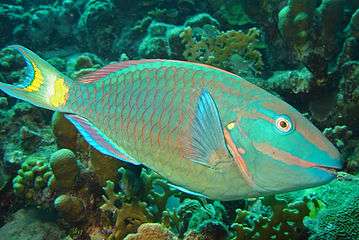Parrotfish
| Parrotfish | |
|---|---|
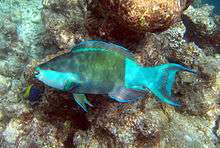 | |
| Scarus frenatus | |
| Scientific classification | |
| Kingdom: | Animalia |
| Phylum: | Chordata |
| Superclass: | Osteichthyes |
| Class: | Actinopterygii |
| Order: | Perciformes |
| Suborder: | Labroidei |
| Family: | Scaridae Rafinesque, 1810 |
| Genera | |
|
Bolbometopon | |
Parrotfishes are a group of about 95 species traditionally regarded as a family (Scaridae), but now often considered a subfamily (Scarinae) of the wrasses.[1] They are found in relatively shallow tropical and subtropical oceans throughout the world, displaying their largest species richness in the Indo-Pacific. They are found in coral reefs, rocky coasts, and seagrass beds, and play a significant role in bioerosion.[2][3][4]
Taxonomy
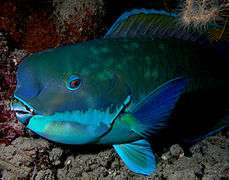
Traditionally, the parrotfishes have been considered to be a family level taxon, Scaridae. Although phylogenetic and evolutionary analysis of parrotfishes is ongoing, they are now accepted to be a clade in the tribe Cheilini, and are now commonly referred to as scarine labrids (subfamily Scarinae, family Labridae).[1] Some authorities have preferred to maintain the parrotfishes as a family-level taxon,[5] resulting in Labridae not being monophyletic (unless split into several families).
Description
Parrotfish are named for their dentition, which is distinct from other fishes, including other labrids. Their numerous teeth are arranged in a tightly packed mosaic on the external surface of their jaw bones, forming a parrot-like beak with which they rasp algae from coral and other rocky substrates[6] (which contributes to the process of bioerosion).
Maximum sizes vary within the family, with the majority of species reaching 30–50 cm (12–20 in) in length. However, a few species reach lengths in excess of 1 m (3 ft 3 in), and the green humphead parrotfish can reach up to 1.3 m (4 ft 3 in).[7] The smallest species is the bluelip parrotfish (Cryptotomus roseus), which only reaches 13 cm (5.1 in).[8][9]
Mucus
Some parrotfish species, including the queen parrotfish (Scarus vetula), secrete a mucus cocoon, particularly at night.[10] Prior to going to sleep, some species extrude mucus from their mouths, forming a protective cocoon that envelops the fish, presumably hiding its scent from potential predators.[11][12] This mucus envelope may also act as an early warning system, allowing the parrotfish to flee when it detects predators such as moray eels disturbing the membrane.[12] The skin itself is covered in another mucous substance which may have antioxidant properties helpful in repairing bodily damage,[10][12] or repelling parasites, in addition to providing protection from UV light.[10]
Feeding
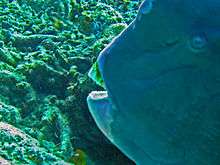
Most parrotfish are herbivores,[9] but some species eat a wide variety of microscopic reef organisms. Some species such as the green humphead parrotfish (Bolbometopon muricatum) include coral (polyps) in their diets.[6] Their feeding activity is important for the production and distribution of coral sands in the reef biome, and can prevent algal overgrowth of the reef structure. The teeth grow continuously, replacing material worn away by feeding.[9] Their pharyngeal teeth grind up the coral and coralline algae[13] the fish ingest during feeding. After they digest the edible portions from the rock, they excrete it as sand, helping create small islands and the sandy beaches of the Caribbean. The green humphead parrotfish can produce 90 kg (200 lb) of sand each year.[14] Or, very averagely (as there are so many variables i.e. size/species/location/depth etc.), about 275 g per parrotfish per day. While feeding, parrotfish must be cognizant of predation by one of their main predators, the lemon shark.[15] On Caribbean coral reefs, parrotfish are important consumers of sponges.[16] An indirect effect of parrotfish grazing on sponges is the protection of reef-building corals that would otherwise be overgrown by fast-growing sponge species.[17][18]
Life cycle
The development of parrotfishes is complex and accompanied by a series of changes in color (polychromatism). Most species are sequential hermaphrodites, starting as females (known as the initial phase) and then changing to males (the terminal phase). In many species, for example the stoplight parrotfish (Sparisoma viride), a number of individuals develop directly to males (i.e., they do not start as females). These directly developing males usually most resemble the initial phase, and often display a different mating strategy than the terminal phase males of the same species.[19] A few species, for example the Mediterranean parrotfish (S. cretense), are secondary gonochorist, meaning some females do not change sex and the ones that do change from female to male while still immature (i.e., reproductively functioning females do not change to males).[20] The marbled parrotfish (Leptoscarus vaigiensis) is the only species of parrotfishes known not to change sex.[9] In most species, the initial phase is dull red, brown, or grey, while the terminal phase is vividly green or blue with bright pink or yellow patches. The remarkably different terminal and initial phases were first described as separate species in several cases, but in some species, the phases are similar.
In most parrotfish species, juveniles have a different color pattern from adults. Juveniles of some tropical species can alter their color temporarily to mimic other species.
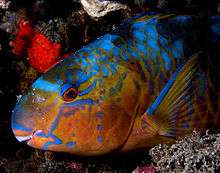
Feeding parrotfishes of most tropical species form large schools grouped by size. Harems of several females presided over by a single male are normal in most species, with the males vigorously defending their position from any challenge.
Parrotfishes are pelagic spawners; they release many tiny, buoyant eggs into the water, which become part of the plankton. The eggs float freely, settling into the coral until hatching.
The sex change in parrotfishes is accompanied by changes in circulating steroids. Females have high levels of estradiol, moderate levels of T and undetectable levels of the major fish androgen 11-ketotestosterone. During the transition from initial to terminal coloration phases, concentrations of 11-ketotestosterone rise dramatically and estrogen levels decline. If a female is injected with 11-ketotestosterone, it will cause a precocious change in gonadal, gametic and behavioural sex.
 Female Scarus psittacus (= initial phase)
Female Scarus psittacus (= initial phase) MaleScarus psittacus (= terminal phase)
MaleScarus psittacus (= terminal phase)
Economic importance
A commercial fishery exists for some of the larger tropical species, particularly in the Indo-Pacific. Protecting parrotfishes is proposed as a way of saving Caribbean coral reefs from being overgrown with seaweed[21] and sponges.[17][18] Despite their striking colors, their feeding behavior renders them highly unsuitable for most marine aquaria.[9]
A new study has discovered that the parrotfish is extremely important for the health of the Great Barrier Reef, it is the only one of thousands of reef fish species that regularly performs the task of scraping and cleaning inshore coral reefs.[22]
Taxonomy

According to the World Register of Marine Species :
- sub-family Scarinae
- genus Bolbometopon Smith, 1956 (1 species)
- genus Cetoscarus Smith, 1956 (2 species)
- genus Chlorurus Swainson, 1839 (18 species)
- genus Hipposcarus Smith, 1956 (2 species)
- genus Scarus Forsskål, 1775 (53 species)
- sub-family Sparisomatinae
- genus Calotomus Gilbert, 1890 (5 species)
- genus Cryptotomus Cope, 1870 (1 species)
- genus Leptoscarus Swainson, 1839 (1 species)
- genus Nicholsina Fowler, 1915 (2 species)
- genus Sparisoma Swainson, 1839 (15 species)
Timeline of genera

References
- 1 2 Westneat, MW; Alfaro, ME (2005). "Phylogenetic relationships and evolutionary history of the reef fish family Labridae". Molecular Phylogenetics & Evolution. 36 (2): 370–90. PMID 15955516. doi:10.1016/j.ympev.2005.02.001.
- ↑ Streelman, J. T., Alfaro, M. E.; et al. (2002). "Evolutionary History of The Parrotfishes: Biogeography, Ecomorphology, and Comparative Diversity" (PDF). Evolution. 56 (5): 961–971. PMID 12093031. doi:10.1111/j.0014-3820.2002.tb01408.x.
- ↑ Bellwood, D. R., Hoey, A. S., Choat, J. H. (2003). "Limited functional redundancy in high diversity systems: resilience and ecosystem function on coral reefs". Ecology Letters. 6 (4): 281–285. doi:10.1046/j.1461-0248.2003.00432.x.
- ↑ Lokrantz, J., Nyström, Thyresson, M., M., C. Johansson (2008). "The non-linear relationship between body size and function in parrotfishes". Coral Reefs. 27 (4): 967–974. Bibcode:2008CorRe..27..967L. doi:10.1007/s00338-008-0394-3.
- ↑ Randall, J. E. (2007). Reef and Shore Fishes of the Hawaiian Islands. ISBN 978-1-929054-03-9
- 1 2 Choat, J.H. & Bellwood, D.R. (1998). Paxton, J.R. & Eschmeyer, W.N., eds. Encyclopedia of Fishes. San Diego: Academic Press. pp. 209–211. ISBN 0-12-547665-5.
- ↑ Froese, Rainer and Pauly, Daniel, eds. (2009). "Bolbometopon muricatum" in FishBase. December 2009 version.
- ↑ Froese, Rainer and Pauly, Daniel, eds. (2015). "Cryptotomus roseus" in FishBase. September 2015 version.
- 1 2 3 4 5 Lieske, E., and Myers, R. (1999). Coral Reef Fishes. 2nd edition. Princeton University Press. ISBN 0-691-00481-1
- 1 2 3 Cerny-Chipman, E. "Distribution of Ultraviolet-Absorbing Sunscreen Compounds Across the Body Surface of Two Species of Scaridae." DigitalCollections@SIT 2007. Accessed 2009-06-21.
- ↑ Langerhans, R.B. "Evolutionary consequences of predation: avoidance, escape, reproduction, and diversification." pp. 177–220 in Elewa, A.M.T. ed. Predation in organisms: a distinct phenomenon. Heidelberg, Germany, Springer-Verlag. 2007. Accessed 2009-06-21.
- 1 2 3 Videlier, H.; Geertjes, G.J.; Videlier, J.J. (1999). "Biochemical characteristics and antibiotic properties of the mucous envelope of the queen parrotfish". Journal of Fish Biology. 54 (5): 1124–1127. doi:10.1111/j.1095-8649.1999.tb00864.x.
- ↑ Murphy, Richard C. (2002). Coral Reefs: Cities Under The Seas. The Darwin Press, Inc. ISBN 0-87850-138-X.
- ↑ Thurman, H.V; Webber, H.H. (1984). "Chapter 12, Benthos on the Continental Shelf". Marine Biology. Charles E. Merrill Publishing. pp. 303–313. Accessed 2009-06-14.
- ↑ Bright, Michael (2000). The private life of sharks : the truth behind the myth. Mechanicsburg, PA: Stackpole Books. ISBN 0-8117-2875-7.
- ↑ Dunlap, M; Pawlik, JR (1996). "Video-monitored predation by Caribbean reef fishes on an array of mangrove and reef sponges". Marine Biology. 126: 117–123. doi:10.1007/BF00571383.
- 1 2 Loh, T-L; Pawlik, JR (2014). "Chemical defenses and resource trade-offs structure sponge communities on Caribbean coral reefs". Proceedings of the National Academy of Sciences. 111: 4151–4156. PMC 3964098
 . PMID 24567392. doi:10.1073/pnas.1321626111.
. PMID 24567392. doi:10.1073/pnas.1321626111. - 1 2 Loh, TL; et al. (2015). "Indirect effects of overfishing on Caribbean reefs: sponges overgrow reef-building corals". PeerJ. 3: e901. PMC 4419544
 . PMID 25945305. doi:10.7717/peerj.901.
. PMID 25945305. doi:10.7717/peerj.901. - ↑ Bester, C. Stoplight parrotfish. Florida Museum of Natural History, Ichthyology Department. Accessed 15-12-2009
- ↑ Afonso, Pedro; Morato, Telmo; Santos, Ricardo Serrão (2008). "Spatial patterns in reproductive traits of the temperate parrotfish Sparisoma cretense" (PDF). Fisheries Research. 90: 92–99. doi:10.1016/j.fishres.2007.09.029.
- ↑ Morelle, Rebecca (1 November 2007) Parrotfish to aid reef repair. BBC
- ↑ Australian Geographic (September 2014). "Single species may be key to reef health".
Further reading
- Sepkoski, Jack (2002). "A compendium of fossil marine animal genera". Bulletins of American Paleontology. 363: 560. Retrieved 2014-05-03.
- Smith, J.L.B. (1956). "The parrotfishes of the family Callyodontidae of the Western Indian Ocean". Ichthyological Bulletin, Department of Ichthyology, Rhodes University. 1.
- Smith, J.L.B. (1959). "The identity of Scarus gibbus Ruppell, 1828 and of other parrotfishes of the family Callyodontidae from the Red Sea and the Western Indian Ocean". Ichthyological Bulletin, Department of Ichthyology, Rhodes University. 16.
- Randall, John E.; Bruce, Robin W. (1983). "The parrotfishes of the subfamily Scarinae of the Western Indian Ocean with descriptions of three new species". Ichthyological Bulletin, J.L.B. Smith Institute of Ichthyology, Rhodes University. 47.
External links
| Wikimedia Commons has media related to Scaridae. |
- "parrotfish factsheet". Waitt Institute. Retrieved 2015-06-08.
- Parrot Fish Profile from National Geographic
- Parrot Fish Care
- Parrotfish info on Fishbase
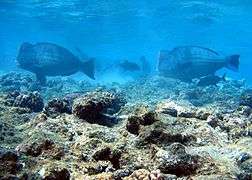
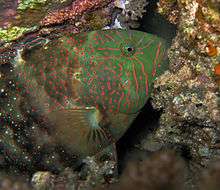
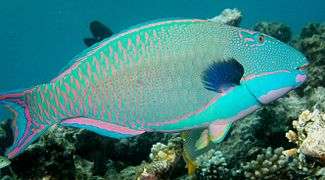
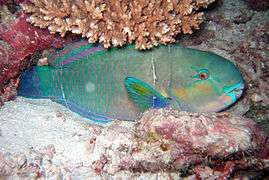
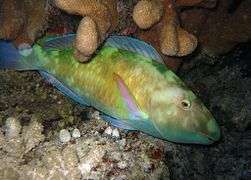
.jpg)
